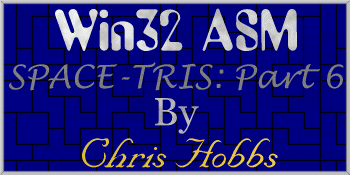11/10 - 11/12 @ Montréal, Canada
12/5 - 12/7 @ Shanghai, China
12/24 - 12/27
2/28 - 3/4 @ San Francisco, CA
More events...
2406 articles in the reference section.
Help us fight cancer!
Join SETI Team GDNet!

|
I Can't See It!After getting it to create and store the piece, I just needed a way to draw it on the screen. I decided to simply modify the existing Draw_Shape() procedure. The idea was, to have it draw either the current shape, or the next shape, based upon a variable that was passed in. Have a look at the new version. The start of that code is pretty self-explanatory. It simply decides which variables to use based upon the piece we are drawing. Take note, that the coordinates 2, and 4, are not pixel coordinates. They are the number of 32x32 blocks on the X-axis, and the number of blocks from the bottom on the Y-axis. There is one major change in the code and that is where I adjust the position of the blocks that are drawn. Because our window we are trying to draw them in is square, but our shapes typically aren't, we needed a way to center them. So, I decided to hard-code in the coordinate adjustments. I used a special technique in order to do this though. You'll notice that I labeled the start of each shape's declaration in the shape table. Remember when we were declaring the shapes by using bits? Well, all I did was place a label before the start of every new shape. This is very, very powerful. I am now able to address the middle of a huge table by name. Needless to say, this adds to the clarity of what would have been a very difficult thing to understand. The only exception to this rule was the square. Because the square was the first shape, I couldn't have two names both at the same place, the first name being, of course, our variable name ShapeTable. So, at the end of ShapeTable I put an equate that said treat 'Square' the same as ShapeTable. In code, I could have easily just used ShapeTable directly ... but then it wouldn't have been as clear as to what I was doing. Finally, in the main code we call this routine both with TRUE, and with FALSE, so we can have both pieces drawn. The next step is to modify the drawing routine to let us change fonts to draw our text. |
|
|
|
|